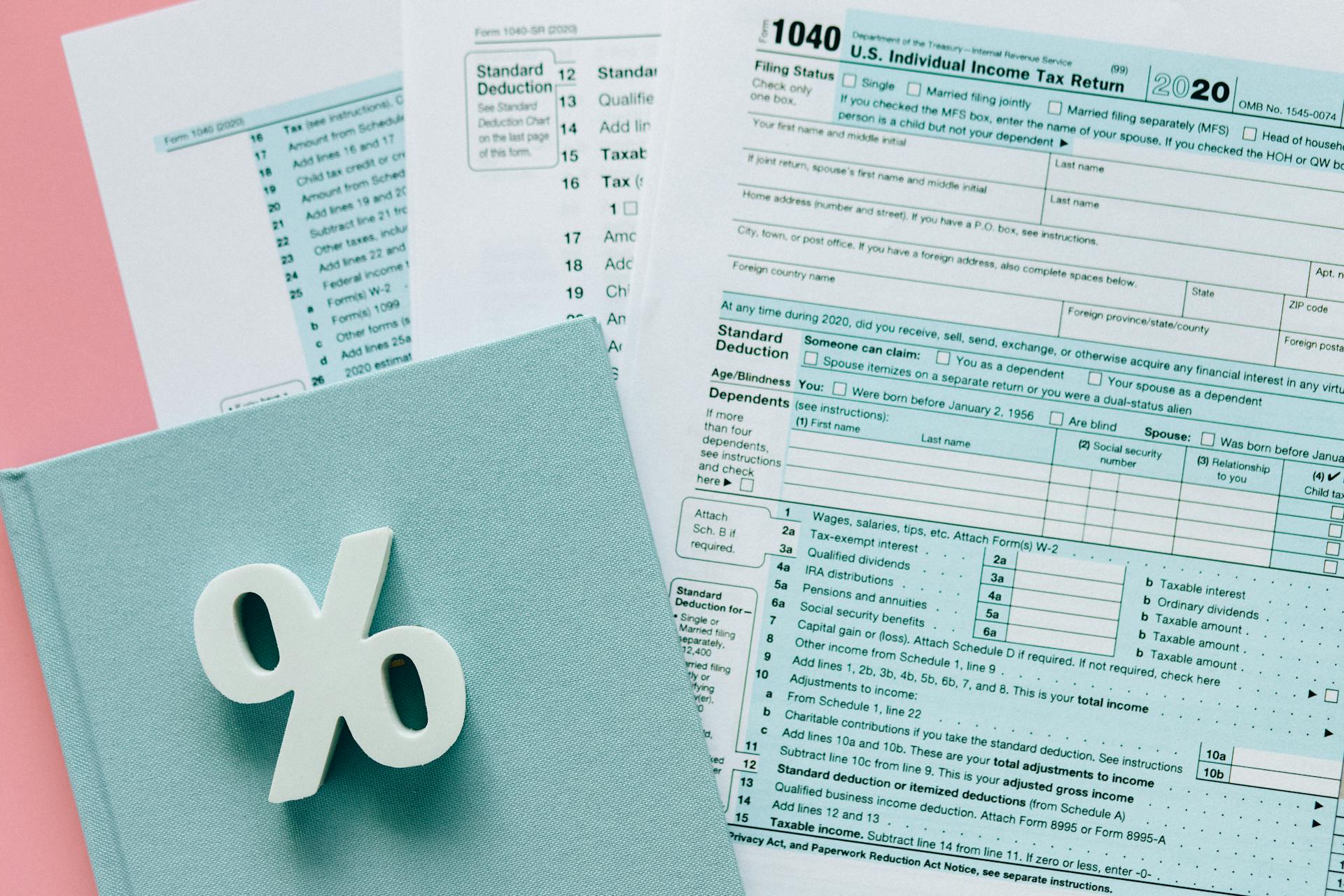
Buying municipal bonds, or muni bonds, can be a smart investment strategy for those looking for tax-free income. Muni bonds are issued by local governments and other public entities to finance projects and pay for services.
To get started, you'll need to have a brokerage account that allows you to buy municipal bonds. Many online brokerages, such as Fidelity and Vanguard, offer this service.
What Are Muni Bonds?
Muni bonds, short for municipal bonds, are a type of bond that's issued by state and local governments to raise funds for various projects. They're a popular investment option for individuals looking to earn a tax-free income.
One of the key benefits of muni bonds is that the interest they pay is federal income tax-free. This is a special carve out that's been in place since 1913, when the US income tax was instituted.
General obligation bonds, a type of muni bond, are often issued to raise funds for large projects, such as building schools or infrastructure. These bonds are secured by the issuer's taxation authority, which means that the debt will be repaid using tax revenue.
There are two types of tax pledges that back general obligation bonds: limited tax pledges and unlimited tax pledges. Limited tax pledges charge annual taxes within the limits of existing laws, while unlimited tax pledges levy taxes in a way that ensures the debt will be repaid, without a limit on the tax rate or amount raised.
School districts, state governments, and local governments frequently issue general obligation bonds, making them a common type of muni bond.
How Muni Bonds Work
You're considering buying a municipal bond, which is a way to lend money to a city, school district, or transportation authority in exchange for regular interest payments and the return of your original investment.
The bond issuer promises to repay the principal, which is the original investment, usually after a set period of time, known as the maturity date, that can be more than a decade off.
You can also invest in short-term bonds that come due in one to three years, providing a faster return on your investment.
Consider reading: Agnc Investment Corp High Dividend Yield
How They Work
Municipal bonds are essentially a loan to a city, school district, or transportation authority in exchange for regular interest payments and the return of your original investment.
You're essentially lending money to the bond issuer for a set period of time, which can be anywhere from one to three years for short-term bonds.
The maturity date, or when the bond issuer repays the principal, can be more than a decade off for some bonds.
Interest payments are usually issued semi-annually, providing you with a regular income stream from your investment.
The bond issuer promises to repay the principal, or your original investment, on the maturity date.
Suggestion: Self Storage Investment Returns
The Economy
The economy plays a significant role in how muni bonds perform. Inflation and rising interest rates can erode the purchasing power of fixed-income investments like bonds.
Investors should be aware that bonds trade in the public markets, just like stocks, and their values fluctuate based on inflation and interest rates. This means that as interest rates rise, fixed interest payments decrease in value, reducing bondholders' overall return.
To reduce the impact of inflation and fluctuating interest rates on bonds, diversifying your portfolio with other asset classes is key. This can be done by investing in Treasury Inflation-Protected Securities (TIPS), whose principal values adjust based on inflation.
Investors can also consider bonds with shorter durations to decrease interest rate fluctuations. This can help minimize losses if interest rates rise.
Here are some strategies to consider:
- Investing in TIPS to protect against inflation
- Purchasing bonds with shorter durations to reduce interest rate fluctuations
Types of Muni Bonds
Municipal bonds come in three main varieties: general obligation, revenue, and conduit. These types of bonds differ in their characteristics and investment potential.
General obligation bonds are issued by states, cities, or counties and have the backing of the issuer's "full faith and credit", which allows them to tax residents to pay bondholders. They provide the most safety among the three types of munis.
Revenue bonds, on the other hand, are secured by the revenue generated by a specific project or asset, such as a toll road or a water treatment plant.
Types of Muni Bonds
Municipal bonds come in three varieties: general obligation, revenue, and conduit. These types of bonds have distinct differences.
General obligation bonds are issued by states, cities, or counties and have the backing of the issuer's full faith and credit. This means they have the power to tax residents to pay bondholders.
Revenue bonds are secured by the revenue generated by a specific project or asset. They don't have the same level of security as general obligation bonds, but they're still considered low-risk investments.
Conduit bonds are not explicitly mentioned in the article, but we know that general obligation and revenue bonds are the two types of municipal bonds.
Municipal bonds are usually considered low-risk investments, with a high expectation of recouping your investment plus interest.
See what others are reading: Private Equity Investments for Small Investors
Revenue
Revenue bonds are more risky than general obligation ones because they're backed by a specific project or source, like highway tolls or lease fees.
Revenue bonds can be non-recourse, meaning if the revenue stream dries up, bondholders don't get paid, and they don't have a claim on the underlying revenue source.
This is a key distinction to understand when considering revenue bonds.
Broaden your view: How to Buy T-bills on Treasury Direct
Agency

Agency bonds are issued by government departments other than the US Treasury, such as the Small Business Administration or the Federal Housing Administration.
These bonds can pay higher interest rates compared to some other types of bonds, but they may not offer the same tax benefits as Treasuries and muni bonds.
Salaries
Municipal bonds are often considered a relatively safe investment option, which can be attractive to those looking for lower-risk investments.
The yields on municipal bonds are typically lower than those on corporate bonds and other taxable bonds.
To put this into perspective, if you're in the 24% federal income tax bracket and find a municipal bond with a tax-exempt yield of 5%, you'd need a taxable bond with a yield of 6.6% to see the same after-tax income benefit.
In higher tax brackets, the difference is even more pronounced, as you'd need a yield of 7.7% from a taxable bond to match the tax-exempt yield of a municipal bond.
Benefits of Investing

Investing in municipal bonds can provide a range of benefits, making them an attractive option for many investors.
Municipal bonds are generally low-risk, with a minimal default rate of 0.09% on investment-grade munis compared to 2.25% for investment-grade corporate bonds between 1970 and 2022.
Adding munis to your portfolio can also help diversify your allocation, reducing overall risk and volatility. By investing in a mix of stocks and bonds, you can mitigate major losses and create a more stable financial foundation.
One of the most significant benefits of municipal bonds is their tax-exempt status at the federal level, and often at the state or local level as well. This can result in higher returns for investors in high tax brackets, as Charles Schwab notes.
Municipal bonds can provide a steady income stream, with interest payments that are typically predictable and reliable. This makes them a great option for investors seeking a regular income, such as those in retirement.
Explore further: Buying a Call Option

Here are some of the key benefits of investing in municipal bonds:
- Diversification: Adding munis to your portfolio can help reduce overall risk and volatility.
- Reduced volatility: Munis can often reduce the volatility of a portfolio, providing a more stable financial foundation.
- Predictable income: Municipal bonds can provide a steady income stream, with interest payments that are typically predictable and reliable.
- Tax benefits: Munis are tax-exempt at the federal level, and often at the state or local level as well, resulting in higher returns for investors in high tax brackets.
By considering these benefits and taking advantage of the tax strategies available, you can make the most of your investment in municipal bonds.
Risks and Considerations
Municipal bonds are not risk-free, and their values can fluctuate depending on market conditions, just like any bond investment.
There are two main risks associated with municipal bonds: interest rate risk and default risk. Interest rate risk occurs when interest rates rise, causing the value of your bond to decrease. This risk can be minimized by limiting the maturity of your bonds.
Default risk is the risk that the borrower (in this case, a municipality) fails to pay back the loan. The default rate on municipal bonds is incredibly low, at 0.08% from 1970-2022, making it similar to Treasury bonds.
However, some experts argue that this risk may be higher due to municipal pension funds being underfunded. To manage this risk, you can consider limiting your investment in municipal bonds with default risk.
You're being compensated for taking on this risk, with federal income tax-free muni bonds offering a 3.19% yield compared to 2.43% for Treasury bonds after taxes.
Here's a brief comparison of the default rates for different types of bonds:
Keep in mind that while the default rate on municipal bonds is low, it's essential to consider your individual risk tolerance and financial goals before investing in muni bonds.
Investing in Muni Bonds
Investing in muni bonds can be a great way to support community projects and potentially earn tax-free income. Muni bonds are issued by municipalities to fund essential projects, and by investing in them, you're essentially lending money to your community.
Muni bonds offer several benefits, including tax exemptions and higher returns compared to other types of bonds. The average five-year municipal default rate since 2012 is a very low 0.1%, making them a relatively low-risk investment.
Investing in munis can be done through your brokerage account or directly from the issuer, and it's a great way to diversify your portfolio and potentially earn some extra income. The interest payments on muni bonds can be higher than those on other types of bonds, and you'll receive the full face value of the bond if you hold it until maturity.
How to Buy
You can buy municipal bonds through a brokerage account, direct from the U.S. Treasury, or indirectly through a mutual fund or ETF.
To start, you'll need to check if your brokerage offers individual municipal bonds. Some brokerages offer new issues and secondary market offerings, while others only offer access via bond funds.
If you find a brokerage that offers individual municipal bonds, you can log into your account and navigate to the products or trading menu. In most cases, you'll find an option for bonds and CDs.
You'll then be presented with a grid of bonds organized by type, along with their interest rates and maturities. Select the category you're interested in to find a list of municipal bonds and select the buy button.
Alternatively, you can invest in municipal bond mutual funds, which are a great way to diversify your exposure to muni bonds while reaping the potential tax efficiency.
Using a municipal bond mutual fund can help you diversify your holdings and create less of a need to manage several different bond holdings on your own.
Curious to learn more? Check out: Invest Stocks Etfs Mutual Funds
How Much Money Do You Need?

Investing in muni bonds can seem daunting, but understanding the basics can help you get started. The minimum denomination for most municipal bonds is $5,000.
You'll also find that some municipal bonds are issued in larger amounts, such as $25,000 or $100,000, to target institutional investors. This can be a good option if you have a larger investment portfolio.
However, if you're a local investor, you may be able to find municipal bonds with a minimum denomination of $1,000. This can make it easier to get started with investing in muni bonds.
Here's a breakdown of the minimum denominations for municipal bonds:
How to Assess
Assessing muni bonds is a crucial step in making an informed investment decision. You should consider the price at which the bond is trading, which can be at a premium, discount, or par.
A bond trading at a premium to its face value means it's trading at a higher rate, while a bond trading at a discount rate means the price is lower than its face value and generates lower yields. A bond with a price at par means it's trading at its face value.
Readers also liked: Why Buy Premium Bonds

Interest rates for muni bonds can be fixed or floating, but most bonds have fixed rates. This means the applied rate won't change, but a floating rate can help combat inflation and rising rates.
The date of maturity is another important factor to consider, as bond maturities can range from one year to as long as 30 years. The longer the duration of your bond, the greater its susceptibility to interest rate and inflation risk.
Here's a comparison of the factors to consider when assessing muni bonds:
Keep in mind that short-term bonds are less vulnerable to interest rate changes but have less time to accumulate interest.
Frequently Asked Questions
Are muni bonds a good investment?
Muni bonds offer relatively high yields compared to similar-risk investments, making them a potentially attractive option for investors. With yields averaging around 55% of investment-grade bonds, munis are worth considering for those seeking a strong return.
Sources
- https://www.forbes.com/sites/investor-hub/article/what-is-municipal-bond-and-how-to-buy-this-kind-of-security/
- https://www.businessinsider.com/personal-finance/investing/how-to-buy-bonds
- https://www.whitecoatinvestor.com/are-municipal-bonds-safe/
- https://www.moneyletter.com/how-to-invest-in-municipal-bonds/
- https://www.ally.com/stories/invest/buying-municipal-bonds/
Featured Images: pexels.com


